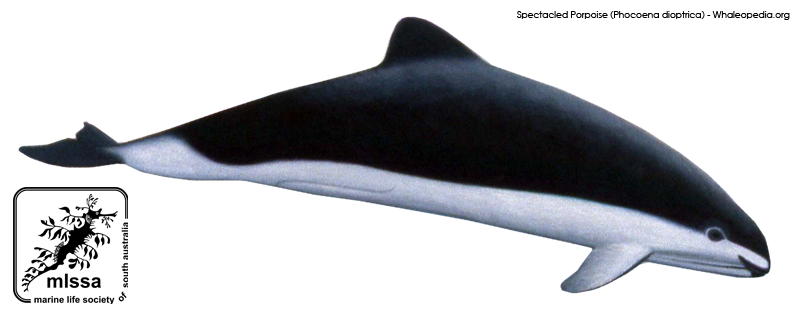SA Whale Centre News
On the evening of Sunday 24th March, the SA Whale Centre received a phone call reporting a dolphin trying to strand itself at Horseshoe Bay, Port Elliot.
Les Mc Diarmid and NPWS Ranger John Bracken attended and realised it was actually a small unidentified toothed whale. Les and John monitored the whales activities, watching as it repeatedly swam in close to shore. When they entered the water, the whale approached and circled them, then swam straight into Les’s outstretched arms, it was very lonely, ill and disorientated. The decision was made to take it to the RSPCA’s Lonsdale Marine Rescue Unit that night, as it was unlikely to survive if left in the ocean.
On arrival at Lonsdale, the whale was assessed by the RSPCA’s vet. The whale species was still unknown until the curator of mammals from the SA Museum, Dr Cath Kemper, arrived. She quickly identified it as a rare spectacled porpoise, having seen one recently being autopsied in New Zealand. The only other Spectacled porpoise ever seen in Australian waters was washed up dead in Tasmania last January.
The Spectacled porpoise was a female calf thought to be only about six months old. She was only about 1.6 metres long, and blood tests showed she was very malnourished and dehydrated. Marine experts at Seaworld in Queensland were contacted for assistance. Assistant curator, Kerry Haynes flew down the next day. The porpoise was force fed water to rehydrate her, also a protein rich type of milk mixture to build up her strength and antibiotics to build up her resistance. Experts from San Diego, Florida and Holland were also contacted for information and advice. Unfortunately, the porpoise was too ill and died early on Saturday 29th March.
The whole exercise surrounding the collection and caring for this rare species was invaluable and everyone learnt a lot. Since then, the various organisations involved, including the SA Whale Centre, have been working together to develop a better live stranding procedure. The SA Museum may display the skeleton in the future.
It is interesting to note that only a fortnight earlier, Les and Polly McDiarmid had attended the whale stranding seminar conducted by the Australian Dolphin Research Foundation. This was reported in our April Newsletter by Steve Reynolds, who also attended. Les obviously made good use of the information acquired at this seminar.

